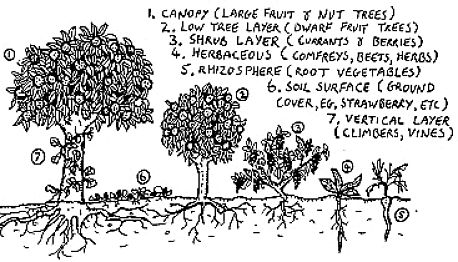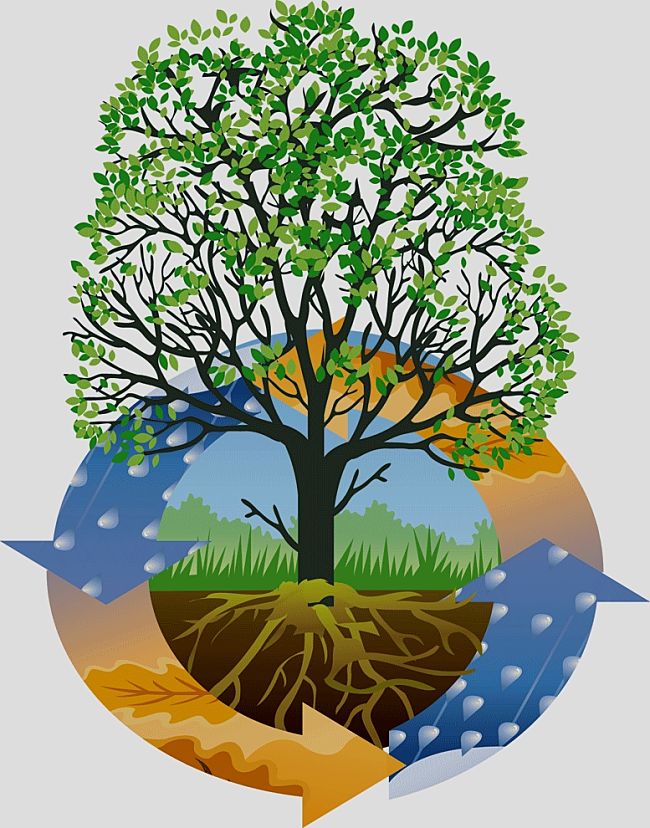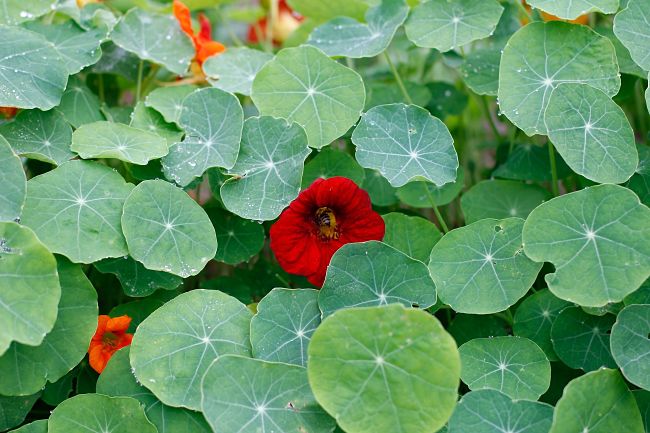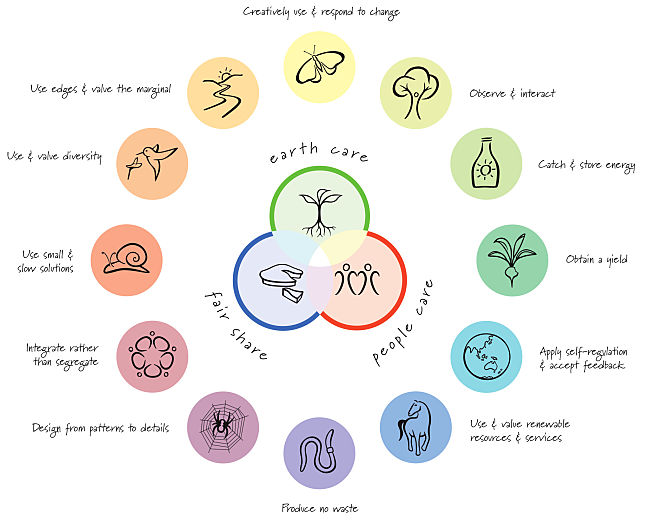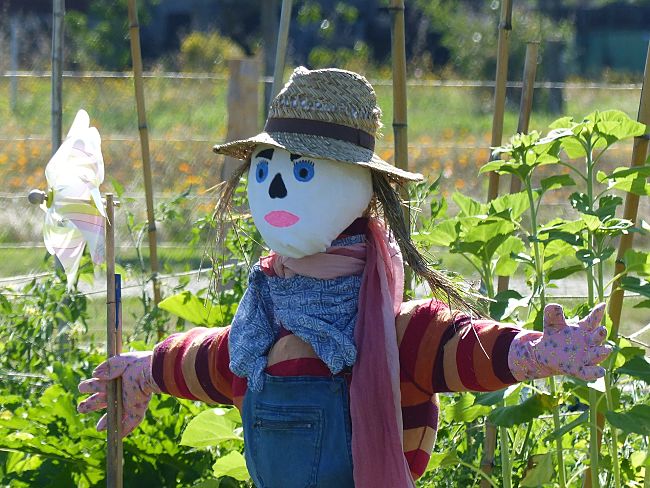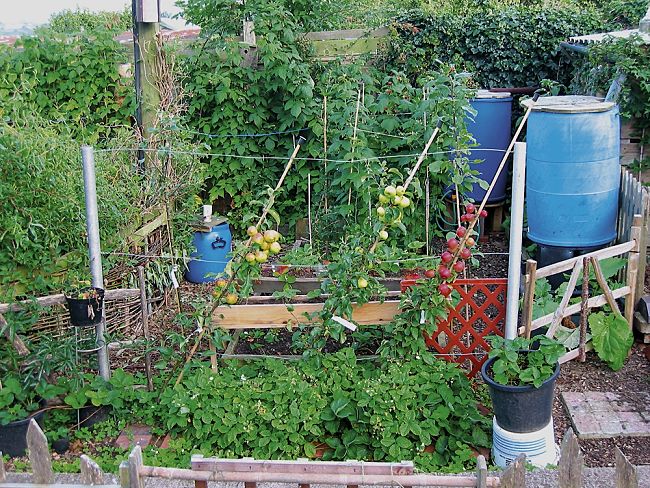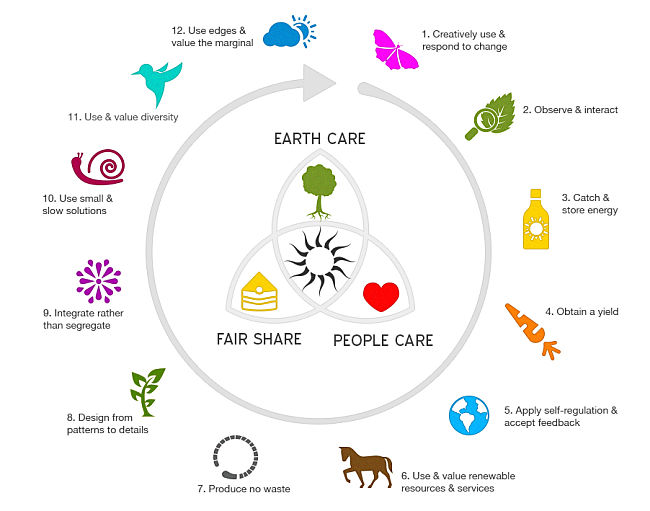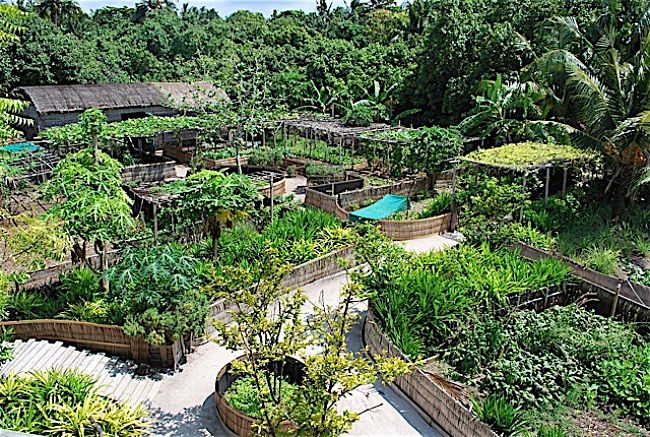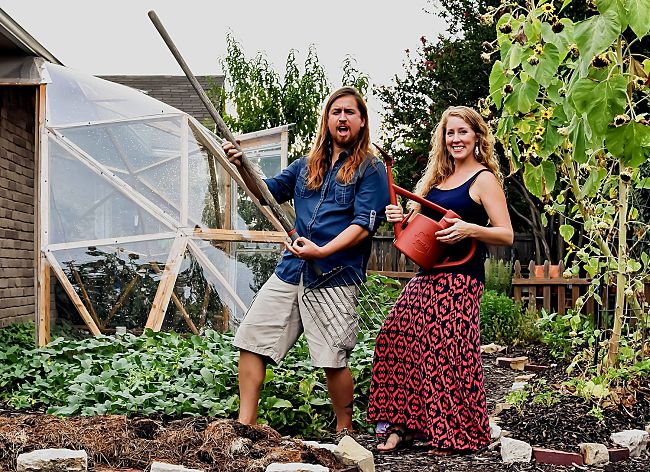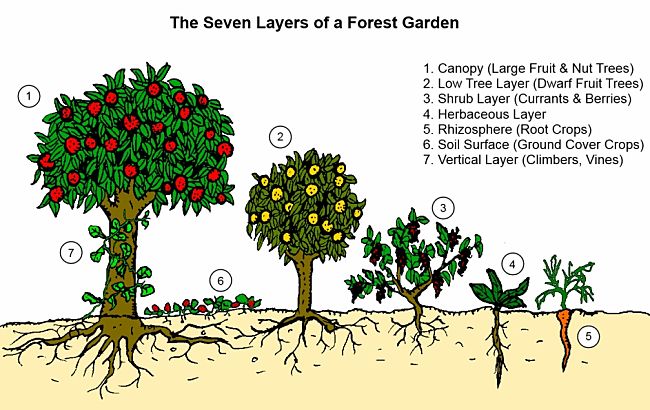Permaculture Boosted by Carbon Sequestration and Carbon Farming Initiatives
Permaculture has always been promoted as a solution for resource scarcity such as oil, energy, arable land and water resources. Permaculture is now very well placed to reap huge benefits as a way of storing carbon in soils and vegetation and as a system for carbon farming throughout the world. This is likely to stimulate new growth in this sustainable farming and gardening method. It can be applied all the way from a tiny home garden to whole farms and regions. It has the potential for generating carbon credits for both soil carbon and vegetation carbon via various integrated permaculture systems including large scale properties and developments such as pasture cropping.
Permaculture is an approach to designing farms, gardens, human settlements and large agricultural enterprises that mimic the way sustainable natural ecosystems function. The word 'permaculture' was invented by two Aussies, David Holmgren and Bill Mollison during the 1970s. It is a combination of 'permanent' (meaning sustainable) and the word 'agriculture'. Permaculture is form of design and sustainable land use that aims to create reliable, productive land use systems that can sustainably provide for human needs with minimal tillage, digging, planting and cropping. Essentially it aims to develop gardens and farms where the land owner can continually pick the fruit and collect the harvest without the normal cycles of ploughing, planting and harvesting.
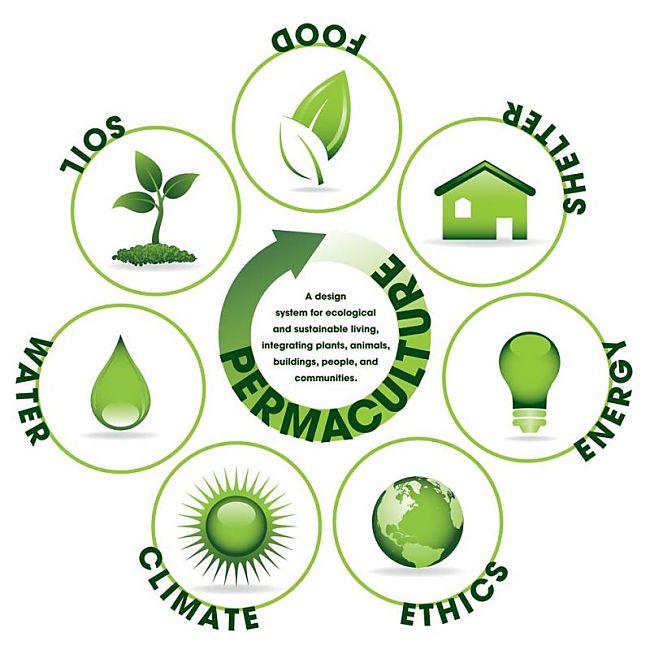
Permaculture promotes an integrated ecosystem approach where landscapes, animals, plants, mulch, water flow, nutrient cycles, weather cycles and climatic factors, are all part of a whole-farm or whole-garden design.
Connections and interrelationships between elements are promoted so that the outputs of one element become the inputs of another element and energy, waste, nutrients, water are naturally processed within the system. In a fully developed permaculture system, work is minimised, nothing is wasted and wastes become resources and humans work with nature and are part of the system, rather than the exploiter and destroyer of natural systems.
Permaculture can increase productivity and yields. It can restore natural systems and can conserve water. It can also be a major way of capturing carbon from the atmosphere and storing it in the soils and vegetation.
Permaculture principles can be adapted and used for virtually any environment and at various scales, from dense urban settlements, to community gardens, to individual home gardens, to small and large farms and to entire regions.
Dense, Complex, Vertical, Resilient and Self-perpetuating
With its design centred on dense and layered planting and scaled projects, permaculture is ideal for small suburban yards, urban community gardens or a even a patio garden.
Permaculture layouts designed to mimic the local ecology of the area, are meant to be dense, complex, resilient, vertical and self-perpetuating. Once the garden or farm has been designed and the planting completed, Mr. Mollison, the founder of Permaculture jokes that “the designer turns into the recliner."
At the lowest level in the garden or a food forest are the below soil crops like carrots and sweet potatoes. Herbs, vegetables, raspberries and other vines and mushrooms go on the next level. Then follows fruit trees and shrubs. At the top maybe the larger trees that yield nuts and fruit (see the diagram). Add the free range chooks (chickens) compost heap, and you're done.
Harvesting such a system is ongoing process of 'continuous picking the seasonal crop' as each plant comes into season and the fruit 'ripens on the vine' and other products are ready to be picked. The harvesting is continuous rather than the conventional 'plough, plant, harvest and fallow' cycle of conventional gardens and farms.
Key Principles of Permaculture
Below are some of the principles of Permaculture that relate to Sustainable Land Management and Carbon Farming:
Diversity - Permaculture Designs are focused on variety and diversity, not monoculture. The aim is to develop sustainable stable and interactive polycultural system that are self-sustaining and provides for human needs. Polycultures are more stable because the resemble the design a natural ecosystems. These Polycultures also store carbon in both the soils and vegetation as the products are picked and collected from trees and crops without whole scale, ploughing, planting and harvesting. Diverse systems are also much more resilient as the elements support each other and the system can adapt to change.
Edge Effect - There is more life along edge between two systems than in the heart of the systems themselves. Systems along the edge can draw on the resources of both parent systems. For example: A pond or dam that has a shallow margin lined with reeds, this edge provides cover and places for fish to breed, for plants to grow and aquatic bugs to thrive which can provide food for the fish. Also, a curved and irregularly shaped edge can provide more edge habitat and provide more benefits.
Energy Planning - The permaculture design should minimise the use of energy (human and fossil fuels), to save energy, time and money. This applies to the internal design as well including the use of gravity and slope to move water through the system. Use trees and slopes to take advantage of cool breezes by directing them into your house. Trees can also be planted as wind breaks to shield your garden and house from the strong winds. Locate the kitchen garden close to the house and the compost heap, to make it easy for maintaining the garden and for harvesting.
Nutrient Cycling - In virtually all natural systems there is no pollution or waste and end products are resources that are interally recycled - the output from one natural element is the resource or fuel for another natural process. Permaculture systems are designed to reuse and recycle the resources and waste as many times as possible within the integrated system. For example, recycling nutrients and carbon on-site via compost, chickens or pigs means that you reduce or eliminate you need for expensive fertilisers. All the wastewater in the system is redirected to ponds, gardens and to groundwater with natural flow systems to direct it to be used for watering plants. This virtually eliminates pollution to the nearby waterways.
Composting - Use worms to decompose organic matter in compost and mulch. The worms aerate the soil and help it store organic carbon. Worms create healthy soil and therefore worms should be encouraged by returning waste organic matter to the soil and by mulching the soil and so creating an environment in which they flourish.
Water Conservation - Permaculture designs incorporates water harvesting and recycling and retention systems so that they typically use only one fifth of water of a conventional garden or farm. Permaculture systems are designed to conserve, store retain, filter, purify and recycle water. This helps to build up carbon stores in the vegetation and soils. If the soils dry out the organic carbon can be lost and the soils can erode, especially if the plants die.
Scale- Create systems with the appropriate scale and ones that use space efficiently. Choose simple, appropriate and effective technologies for your scale and design. Permaculture systems are ideal for Starting small and progressing through a series of achievable steps to reach your final goal. This adaptive management means that you learn along the way and can change as you learn.
Biological Resources - Make creative use of natural systems, methods functions and processes to achieve various tasks. This will make things a lot easier. Work with nature rather than against it. For example: Chickens like to scratch and pigs like to rout though organic matter. Use chickens to scratch up area and to eat weeds, seeds and pests such as snails. Chickens also fertilise the area.
Use Natural Succession - Work with nature and understand the natural succession processes of natural systems. When establishing an orchard or garden, the more vulnerable plants may need to be protected from sun, rain and wind. Slow growing plants may not be good pioneers and you may need ways of supporting them until they get established. Use hardy and fast-growing pioneer species to create the good environment for the succession to the permanent species. Shade is a great tool that can be used to control weeds and to allow the pioneer species to be replaced.
Use Replication in the design - Where possible grow many types of food - nuts, legumes, herbs, leafy greens, fruits, grains, herbs, tubers and vegetables to guard against the failure of one crop. Develop multiple sources of water such as river, dam, pond, tank, town water, bore, well, etc. This will guarantee supply. Look to providing each vital need, requirement and function in several different ways and always be looking for multiple ways of doing things.
Multiple Functions - In a Permaculture system everything should have many functions and uses and functions and aim for at least three. Trees provide shade and wind breaks, store carbon and can be used for firewood and as a source of mulch.
Reciprocity - Use the products from one element to satisfy the needs of other elements. The output from one element can be an input for another element, for example kitchen scraps are the waste from the kitchen but are inputs to the compost pile which in turn provides organic mulch and fertiliser for the garden. The output of the garden is food for the kitchen.
Relative Location - The various components of the system showed be carefully placed close to others so that they can benefit each other. Use companion plantings and replicate the association of natural ecosystems. For maximum efficiency place those things that are used together or are linked in places close together. This makes more efficient use of space and cuts down on energy and movement costs. For example,where possible, position the compost heap close the kitchen. Also site the vegetable garden in a location where here will be natural flow of water from the compost area and chicken pen so the nutrients and water will help in the garden.
Permaculture and Carbon Credits
Permaculture is not strictly speaking a form of agriculture, rather it is an ecological design method that can be used to design sustainable agricultural systems. It is based on understanding how natural systems operate, and the relationship between the elements and processes.
Permaculture is highly adaptive and adopts a wide range of techniques that are appropriate to the function, goal or operation of the system. Permaculture designs may include holistic management grazing, agroforestry, sustainable forest gardens, silvo-pasture, eco-building designs, renewable energy, biofuels, rainwater harvesting and a wide variety of modern sustainable agriculture methods such as pasture cropping and Natural Sequence Farming. It is this diversity of ideas which expands on the Permaculture principles to create major opportunities for storing carbon.
Permaculture designed plantations are ideal for generating Carbon Credits and Carbon Farming in the following ways:
- Soil carbon is increased by reducing inversion ploughing on farms to a minimum. Soil fertility and carbon storage are increased though mulching composting and adopting 'soil food web' using compost and worms in permanently planted beds. The use of long rooted plants and keyline planning and other strategies that can help build organic matter content and substantial soil fertility. Much of the composting is done in situ by heavy application of organic matter directly onto the garden beds.
- For grazed land, keyline planning. pasture cropping and various holistic management strategies can dramatically increase soil carbon levels. These methods have been widely developed and tested by groups such as Carbon Farmers of America and similar groups in New Zealand and Australia.
- Building soil and restoring soil fertility and ecosystems fixes carbon into the ground. Various research studies have shown that soil carbon sequestration can equal or exceed carbon storage in trees and vegetation, and the carbon is locked-up for longer periods of time. Carbon sequestration in soils is often referred to as "carbon farming" but the term is also applied to all types of carbon storage - soils and vegetation. Carbon Farming is now being used globally to mitigate climate change.
Pasture Cropping an Offshoot of Permaculture Applied to Agriculture
Pasture cropping is a method where a crop is planted directly into a pasture without ploughing. Pasture cropping sustains the topsoil and leaves it undisturbed, while simultaneously producing a grain crop. It provides a win-win outcome as it improves perennial pasture, feeds livestock and provide a crop to harvest all in the same paddock!
- Normal cropping methods, even organic methods, requires the soil to be turned over and left bare and vulnerable as a skeleton or nude soil prior to planting the grain. Carbon farming, holistic farming and permaculture have clearly shown that disturbing soil structure and leaving the soil bare is not ideal and destroys the soil food web, causes erosion, and loss of fertility and organic carbon stored in the soil.
- Pasture cropping requires good timing and forethought and planning, but essentially direct drilling and other methods allow cereal crops to be seeded directly into perennial native pastures. The cereal crop grows symbiotically with the pasture grasses, for mutual benefits for both the crop and pasture.
- The yields from a field can be good, if not better, than cropping conventionally due to the better soil fertility, weed control and soil moisture, while retaining the perennial pasture. Animals can be allowed back into the pasture immediately after the crop is harvested. Pasture cropping preserves the soil structure, caused no loss of topsoil through erosion and builds organic biomass and carbon storage in the soil.
- Using Holistic Management Techniques the grazing animals such as goats, cattle or sheep add biomass and available nutrients to the pasture increasing soil fertility and depth.
Research studies have confirmed the benefits of pasture cropping on total cover, biomass, nitrogen and soil moisture.
